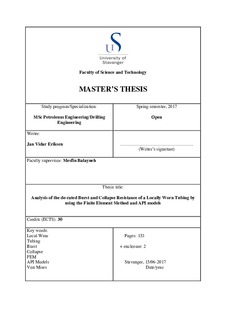Analysis of the de-rated Burst and Collapse Resistance of a Locally Worn Tubing by using the Finite Element Method and API models
Master thesis
Submitted version
Permanent lenke
http://hdl.handle.net/11250/2462257Utgivelsesdato
2017-06-15Metadata
Vis full innførselSamlinger
Sammendrag
A well integrity survey performed by the Petroleum Safety Authority showed that tubing related problems are a major issue on the Norwegian Continental Shelf. Caliper log runs carried out by ConocoPhillips revealed that the production tubing in a bent section contained local scars with a wall thickness reduction up to 47%. In order to ensure a sufficient well integrity, a accurate prediction of the de- rated tubing strength is important. Today, the most common methods to estimate the de-rated burst and collapse pressures of a damaged tubing are the API models, which assume a uniform wear. In this thesis the Finite Element Method have been applied in order to investigate if the API models also are applicable for a locally worn tubing.
Three different local wear shapes have been simulated, referred to as crescent, wedge and rectangular shaped. The results shows that as the wear depth increases up to 50%, the deviation between the FEM results and the API model for burst reaches up to 71%, 114% and 147%, respectively. The models for collapse showed a similar trend, but with a significantly lower deviation compared to the burst model.
According to the FEM results the API models can not be applied for a tubing with a local wear. The overall results proves the need to perform a FEM based analysis for a locally damaged tubular in order to ensure sufficient well integrity.
Beskrivelse
Master's thesis in Petroleum engineering
